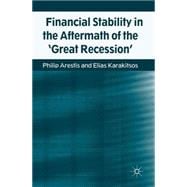The financial crisis and the ensued 'great recession' are primarily caused by the excessive liquidity that was created in the last thirty years or so of inequality that benefited greatly the financial sector, deregulation and financial liberalisation as well as financial innovation, which are based on the supposedly superior intellectual model of the Efficient Markets Hypothesis. There were also contributory factors that accentuated the process, such as international financial imbalances, the monetary policy pursued at the time, and the role played by the credit rating agencies. The New Consensus Macroeconomics model that forms the backbone of the way the economy works and how monetary policy should be formulated in theory and practice is scrutinised. It is argued that the traditional approach of viewing housing as a capital good must be dropped and housing should be viewed as a speculative asset, akin to equities. This new theorising is necessary as in the traditional approach bubbles cannot exist. A chapter is devoted to the causes of the European Union (EU) debt crisis, the reasons why the crisis has dragged on, the remedial treatment applied so far, offering alternative viable solutions to the crisis and examining the channels through which the EU debt crisis might spread to the rest of the world. Finally, the book draws on the lessons for theory and policy from the recent experience and discusses in detail the new regulatory environment that policymakers attempt to put in place to avert another credit crisis.








